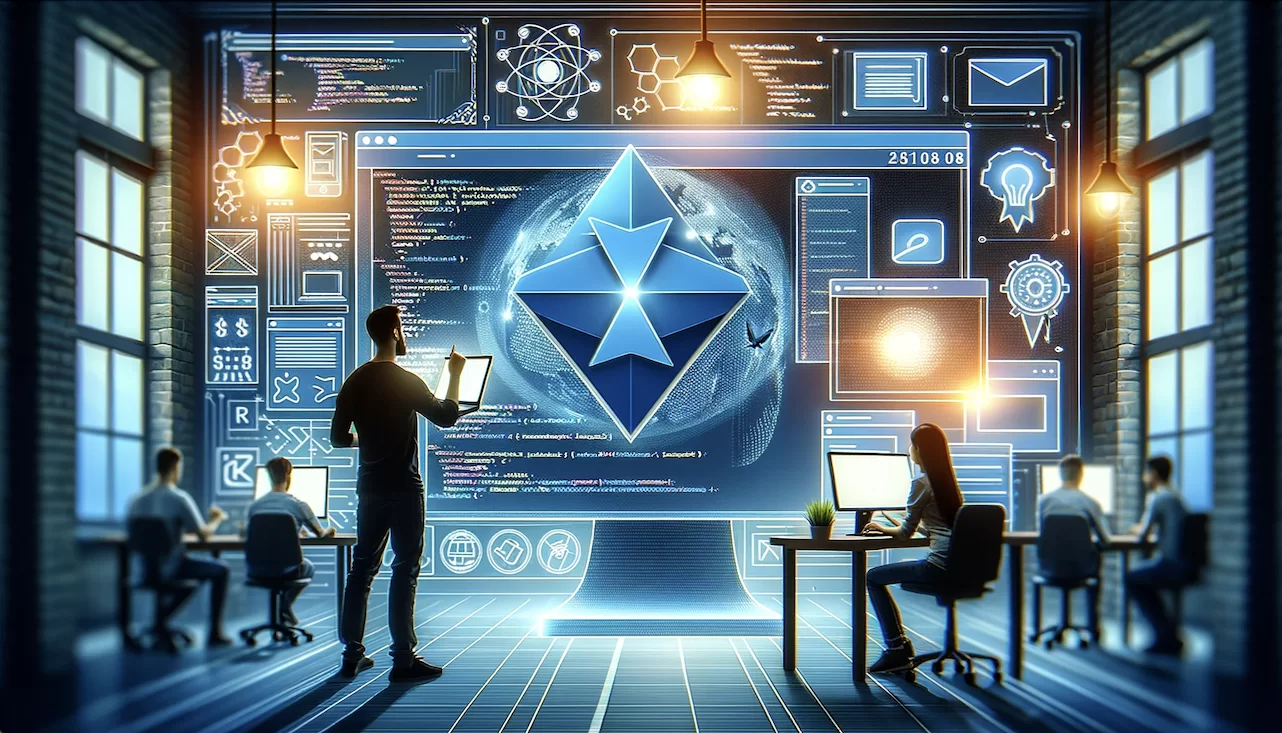Next-Gen UI Components: Elevating User Interfaces with JavaScript in 2024

Developers, are you ready to think beyond traditional UI components and move with the next-gen UI components and JS frameworks in the year 2024? You have come to the best place to read about it. User interfaces are quite important since they map the gap between users and digital technology. Since the current UIs are a mix of both traditional and modern approaches the rise of new technologies such as AI, and IOT makes the need for modern user interfaces to move forward. However, when it comes to a next-gen UI component developed with a JavaScript framework they are a lot more than traditional button clicks. They are a combination of UI components that are smart, ready to mimic your needs, and give you a mesmerizing user experience. In this article let’s dig deep into how to elevate your user interfaces with Javascript in 2024.
Evolution of UI Components
Starting with a brief history of UI components, before 2000 it was all static HTML along with libraries like Prototype.js to add animation. Afterward during the 2000s, it could be called a decade in which different JavaScript frameworks and JavaScript libraries started rising. In here popular Javascript web frameworks like Angular and Backbone came and they supported single-page applications. Finally, the era from 2010 to the present day is characterized by component-based JavaScript front-end frameworks such as open source javascript framework React, Vue js framework, and Sencha ExtJS, along with JavaScript libraries and CSS libraries.
Shifting our focus to the challenges, one is the complexity of the UI framework which is a hassle for the developers. This also results in a steeper learning curve as well. Performance is also one of the challenges since it’s not the easiest to meet component flexibility while efficiently rendering. Another challenge is the accessibility gaps since not all UI component frameworks have accessibility built in. Last but not least, limited customization poses a challenge, as it may restrict the ability to tailor components exactly as desired.
Let’s now explore the possible advancements and improvements of UI components. One is the concept of low-code/no-code tools, here the non-developers also get the capability of building simple UIs. Next are improvements in interoperability between UI components while supporting advanced cross-platform app development and enterprise software development. The third is AI-powered UI where AI assists in user research, layout optimization as well as checking on component behavior. Another possible addition is voice and gesture interfaces which will bring in a non-touch experience. Finally is dynamic personalization where the UIs will adapt based on the user’s preferences and real-time data.
The Power of JavaScript in UI Development
Javascript is recognized as one of the dominant forces in shaping dynamic and interactive web experiences. This is considered as such due to its smooth interactivity, support to build SPAs, and the ability to create richer UI elements such as Javascript grid using a well-performing javascript library.
Some of the key features of the most popular JavaScript frameworks are they contribute to UI development by virtual DOM manipulation and event handling. Another is asynchronous programming with two-way data binding where multiple tasks are handled simultaneously. Finally, another key feature is the availability of a large number of javascript libraries as well as javascript frameworks that provide support to pre-built components and tools.
Talking about the enhanced capabilities expected in a JavaScript framework or JS library by 2024, one improvement is its integration with WebAssembly, which allows developers to write performance-critical code in languages like C and connect it with JavaScript for UI tasks. The next capability is advanced animations and graphics, allowing for a more immersive web experience. The third is enhanced accessibility features to create UIs for users with disabilities. Last but not least are the enhancements in the AI-powered UI development process.
Next-Gen UI Components: Definition and Characteristics
Next-gen UI components are advanced and latest user interfaces that integrate advanced features and functionalities. Their role is to enhance and personalize the user experience while mapping the physical and digital world along with the use of AI to predict user needs, automate tasks, and optimize workflows.
Moving on to the characteristics that set them apart from the traditional UI components one is its proactivity and contextuality where they predict user needs and adapt accordingly. Another is they are more focussed on AI as well as they use voice/gesture recognition capabilities. Also, these components are capable of integrating with the physical environment as well as other devices.
Talking about some examples from the industry or applications that can benefit most, one is healthcare with the use of things such as AI-driven medical image analysis. Next is education materials such as enabling VR learning experience. Third would be retail where they would be able to predict customer preference. Another is the manufacturing field where real-time data visualization on factory floors can be done. All in all, it could be seen that almost all industries can get support in one way or the other.
Showcase of Next-Gen UI Libraries and Frameworks
Some of the leading UI libraries and javascript frameworks in 2024 and their practical applications are as follows.
- React Spectrum – Built for complex and data-dense applications such as Adobe’s Creative Cloud apps.
- Fluent UI – This is cross-platform and applications like Microsoft Office 365 and Teams are based on this.
- Quasar – This is mainly performance-driven and ideal for cross-platform mobile applications and web applications.
- Sencha Ext JS – One of the best UI frameworks, it offers a rich set of UI components and practical applications in CRM systems.
Let’s dig deeper into what front-end framework Ext Js’s features make them next-gen. The first is its comprehensive component suite which offers over 14O prebuilt UI components and its built-in functionality supports filtering, grouping, and much more. It also has a high-performance architecture that optimizes rendering which makes it the best javascript framework. You can also apply pre-built themes. On-demand customization and data management are also a key feature since it gives seamless integration with UI components. All in all these features help Ext JS a powerful choice for building next-generation applications.
Seamless User Experiences through Reactive UI
Reactive UI is a programming concept where user interfaces are created to dynamically respond to changes in data or state. Another important fact is how reactive programming in JavaScript improves user experiences. The answer is it supports smooth transitions real-time updates and efficient data and performance handling. It also allows scalability for complex applications, and the declarative nature of reactive programming often leads to more readable and maintainable code.
Let’s now explore some of the real-world examples showcasing the impact of reactive UI in 2024. Collaborative editing platforms are one of the best examples by allowing multiple users to work on shared documents and see each other’s changes in real-time. Personalized real-time product recommendations also enhance the impact of reactive UI. Moreover, live chats and customer support systems also show the practical applications and benefits of reactive user interfaces in enhancing user engagement and experience.
Also Read: How To Choose the Best JavaScript Frameworks In 2023
Microinteractions and Animation in Next-Gen UI
Microinteractions are small functions that occur in response to a user action. Even though these are very small, they help enhance user engagement by adding a more tangible and enjoyable touch-and-feel experience. The best example here is the use of animations. Building upon how animations will make a polished and modern UI. Some of the ways it will enhance clarity and focus are by methods like highlighting the focussed elements. Also using animated transitions will help to keep the user’s trust. It will also bring an emotional connection making the user’s mind happy. Also, the use of smooth and purposeful animation makes the UI attractive and modern.
Some creative examples of micro-interactions and animations are Spotify’s progress bar where the album expands and contracts. Another is Apple’s pull to refresh. Slack’s emoji reaction is also one such example since it plays a playful animation.
Ensuring Accessibility and Inclusivity
When developing a web application it should be accessible to every user regardless of their abilities. The significance of an accessible UI design is you should ensure that everyone can access and benefit from your UI. Also, most countries have legal requirements on accessibility that all websites or web apps should adhere to. Another significance is if your application is accessible for diverse needs it will have a high market reach which enhances your brand image as well.
Let’s now explore some features and practices for creating accessible and inclusive next-gen UI Components in UI frameworks.
- Keyboard navigation.
- Color contrast.
- Screen reader compatibility.
- Alternative text descriptions.
- Highlight focused elements with clear visual cues.
- Responsive design to adapt to different screen sizes.
Some of the real-life examples highlighting successful implementations are Apple’s voice control, Airbnb’s accessibility filters, Google’s live captions, and Microsoft Office’s accessibility checker.
Overcoming Development Challenges
When adopting and implementing Next-gen UI components many challenges arise. In this section let’s discuss what the challenges are and how to overcome them.
One of the challenges are steeper learning curve which is a hassle for developers who have been working with traditional frameworks. Another is many next-gen components are still under web development and its instability brings risk when adding the feature to old frameworks. Also, these features have limited browser support as well. Another challenge is the integration of these next-gen UI components into our already existing frameworks which is not the easiest to do as it will introduce performance issues.
On the other hand, let’s discuss the strategies and solutions to overcome these challenges. The first is to start the web development as small projects or experiments. Make sure to keep in touch with the rest of the community to understand issues at their earliest. Also, make sure the features work across older browsers. Keep in mind to structure your codebase to isolate next-gen component integration, making it easier to manage and update independent modules. Don’t forget to regularly test and optimize the performance.
Tips for ensuring smooth integration and development workflow.
In addition, some of the tips are as follows.
- Maintain standard coding practices.
- Always use testing tools so that regressions and bugs can be identified at the earliest.
- Invest in documentation so that you can easily adapt since it has code examples.
- Keep yourself informed about updates and bug fixes for your chosen components adapting your code as needed to maintain stability and best practices.
- Continuously communicate and collaborate with fellow developers.
The Future Landscape of UI Development
The future of UI development could be interfaces that map the digital and physical world. So in this section let’s discuss what’s awaiting beyond 2024.
Predictions for the continued evolution of UI development beyond 2024
Talking about the predictions there are numerous but let’s sum up the closest possibilities. One is the beyond-screen concepts with interfaces AR/VR to support virtual workspaces. Next, is UI’s that will read our emotions and biosignals to personalize interactions. Also, the use of voice with UI will become a major input method with accessibility. Finally, is a more adaptive and self-learning UI component that will ease the developer’s work.
Emerging technologies influencing the future of UI components
There are several emerging technologies. One is generative AI which helps in creating personalized and dynamic UI elements on the fly. Another is haptic feedback in which physical and digital experiences are combined such as a virtual VR game. Last but not least is Blockchain and Decentralization which enables secure and transparent ownership of digital assets within UIs such as buying and trading virtual goods directly through an AR storefront.
Guidance for developers to stay ahead in the dynamic UI landscape
As developers, you should always stay ahead to deal with this dynamic change in UI development. So for that you should always stay updated on the latest technologies, play out and experiment with new tools and frameworks, and also sharpen your knowledge of the new AI introductions. Also, you should focus on more user-centric designs and as discussed in the above sections collaborate and communicate with other UI developers.
Conclusion
In summary, next-gen UI Components along with JS frameworks bring the potential for web and software development with more interactive, adaptable, and efficient UI. As we move into 2024, it’s now in the developer’s hands to explore JS frameworks and their key features to bring in a mesmerizing application or website to the end user. Continuously keep track of the new updates about JS frameworks to get the best user experience out. Elevate your user interfaces in 2024 with Next-Gen UI Components, powered by Ext JS.
FAQs
What are Next-Gen UI Components?
Next-gen UI components are advanced and latest user interfaces that integrate advanced features and functionalities. With JS frameworks these components go beyond features like traditional buttons and forms and bring in capabilities to dynamic, adaptive, and interactive user interfaces.
Why is JavaScript crucial for Next-Gen UI Components?
Javascript is crucial since it’s constantly evolving along with its mind-blowing features which are virtual DOM manipulation. event handling, asynchronous programming, and numerous javascript libraries and JS frameworks.
What’s the future of UI development beyond 2024?
The future of UI development and JS frameworks is interfacing beyond screens such as integrating AR/VR, AI-powered personalizations, emotion-driven interfaces as well as adaptive and self-learning components.

Software testing has always been a critical part of software development. It allows us to…

Software testing has always been a critical part of software development. It allows us to…

Software testing has always been a critical part of software development. It allows us to…



 Rapid Ext JS (beta)
Rapid Ext JS (beta)













